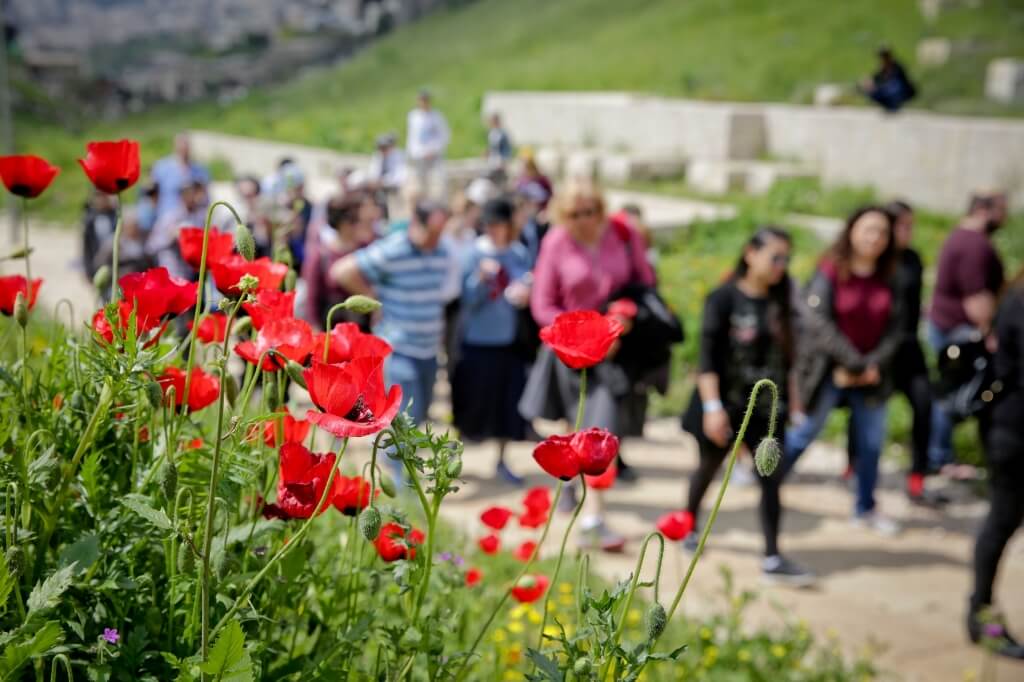Once filled with water, the ancient channel of the Kidron Stream forms the eastern border of the narrow valley in the City of David, safeguarding numerous discoveries and historical episodes from both distant and recent times within it.
In the northern part of the Kidron Valley, near the cemetery on the Mount of Olives, there are ancient burial caves and stone monuments, including the Tomb of Avshalom, the burial site of Benei Hezir, and the Tomb of Zechariah. Interestingly, on the Mount of Olives itself, remarkable figures were buried, such as Henrietta Sold, Shai Agnon, Menachem Begin, Pinchas Rosenberg, Rabbi Kook, and more.
Ancient times’ relic
The Gihon Spring, flowing at the foot of the City of David, on its western side along the Kidron stream, served as the main water source for the city since the Jebusite period. In ancient times, the level of the Kidron channel was much deeper than it is today, and the waters of the Gihon flowed about a meter above the stream’s bed and into it.
Towards the end of the 19th century, German researchers Conrad Schick and Hermann Guthe uncovered the ancient Canaanite aqueduct that led water from the Gihon Spring southwards towards the agricultural areas of the Kidron Valley. This aqueduct was part of Jerusalem’s ancient water system. On the western side of the Kidron stream, British archaeologist Kathleen Kenyon discovered two walls from different periods – one from the Middle Bronze Age (18th century BCE) and the second from the First Temple period.
The World’s Largest Biblical Park
Today, the Kidron Valley is part of the “Jerusalem Walls National Park” managed by the Israel Nature and Parks Authority. The park includes The City of David, the Gey Ben Hinom, Emek Tzurim, the Old City walls, the Dung Gate, and the Ophel excavations, and can be called the “World’s Largest Biblical Park.”
Starting from 2006, at the edge of the Kidron Valley, the City of David Information Center operates on the Mount of Olives. The center provides information services about the sites of the Mount of Olives and the cemetery. Through it, assistance can be obtained in locating graves and identifying the buried individuals.
The spectacular poppy blossoms
Every year, as spring approaches, countless poppies burst from the ground, filling the Kidron channel with a carpet of vivid and dazzling red blossoms. On Fridays, throughout the blooming period, special flower tours depart from the City of David to the accommodation tent in the Kidron Valley.
Last year visitors could enjoy family activities and workshops like flower weaving and magnet photography. In addition, participants coulld visit a fascinating and unforgettable visit to the magnificent monuments that adorn the Kidron stream, named the “Petra of Jerusalem,” which were carved into the rock of the mountain thousands of years ago. An authentic and delicious light meal was served in the accommodation tent.
In addition to the tours that showcase the beauty of the blossoms and the various related activities. Various events take place throughout the year in Kidron Valley. At different times throughout the year, a musician sits near the Tomb of Avshalom, greeting visitors with music, and from time to time, poetry readings are held around selected events throughout the year.
What Awaits You This Year?
This year, you are invited to join the “Combined Ticket”, a special ticket that offers a unique experience of past and present, ancient crafts, and the beauty of spring in bloom.
The journey begins at the farm in the valley in Gei Ben Hinnom, where you will experience activities such as weaving with seasonal plants, candle-making from beeswax, and traditional mud-brick building. You can also watch fascinating demonstrations of goat milking and cheese-making, blacksmithing, traditional pottery, and music played on ancient instruments. Additionally, you can walk on Israel’s longest suspension bridge.
From there, you will take a shuttle to the Kidron Valley, where you will discover the stories behind its impressive monuments – Absalom’s Tomb, Zechariah’s Tomb, and the Tomb of Benei Hezir – on a guided springtime tour. You will also enjoy a children’s play, a family challenge .game, and traditional hospitality in an ancient-style tent
This is the perfect time to go out with the family, explore, and enjoy the spring.









